|
|
|
|
|
|
|
 |
|
Nomina
Sacra |
|
The
use of certain standard abbreviations for the names of the deity or for
certain highly sacred concepts dates from the earliest Christian manuscripts.
The fact that this was not done for speed, efficiency or the saving of
space is emphasised by the fact that not only do these abbreviations appear
in the most formal of manuscripts, they are part of elaborate decorative
headings. The nomina
sacra are really a form of sacred visual code. |
|
|
Depictions
of the deity in word or visual form seemed to pose difficulties. The above
is a representation of the Holy Trinity from a 15th century alabaster
tomb in the parish church of Methley, Yorkshire. |
|
The
nomina sacra abbreviations have something in common with other coded visual
representations of the deity, such as the chi-rho
monogram, the Chrismon
symbol used on Frankish and German diplomas,
the agnus dei, the monogram of the Holy Trinity
found in medieval art or the most fundamental symbol of Christianity,
the crucifix. They are the symbolic representation of a deity that is
difficult to represent in a literal form as the Christian God of the middle
ages was a very difficult concept to get your head around. |
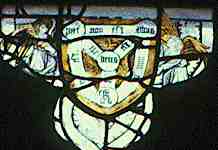 |
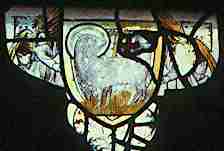 |
| Images in the tracery lights of a 15th century stained glass window in Thornhill parish church, Yorkshire. |
|
At
the very top of the tracery lights is the Holy Trinity monogram in which God, Deus in the middle is linked to circles representing the Father, Son and Holy Ghost
with the word est (is),
while the three components are linked by banners reading non
est (is not). In the next tracery light
is the agnus dei symbol for Christ comprising
a haloed lamb with crucifix and flag. |
 |
 |
|
On
the left is a Chrismon symbol, from a diploma of Charlemagne
of AD 781 (Marburg, K. Preussisches Staatsarchiv) while above is the equivalent
from a diploma of Emperor Konrad III from 1139 (St Gall, Stiftsarchiv). |
| The Chrismon symbol may have been derived from the chi-rho symbol for Christ, but in Germanic diplomas it developed calligraphic elaborations which altered its form, but not its meaning. |
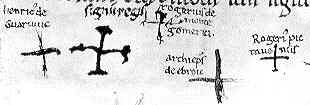 |
Crucifix
symbols in a late 11th century charter in Eton College Library. |
| The symbols of the crucifix which are found on early English charters are simpler in form, but their presence beside the names of the witnesses indicate that they have taken an oath before Christ to the veracity of the document. |
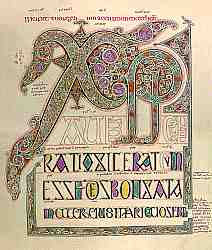 |
The fact that the chi-rho or XPI symbol for Christ is not a mere abbreviation is attested by the very elaborate, nearly full page decorative treatment that it received in some early gospel books. This is a potent symbol. |
Chi-rho page from the Lindisfarne Gospels, Matthew
i. 18, f.29 (British Library, Cotton Nero D IV). |
|
When
it comes to the symbols which are actually incorporated as part of the
written text, highly significant passages of sacred text may be heavily
abbreviated. The following is one of my favourite passages from the Vulgate
Bible, the beginning
of the gospel
of St John. They revered it in the middle ages too, as it often comes
in for special treatment in the decoration of the text. When you read
it aloud in Latin it forms an interlinking chain of repeating words. |
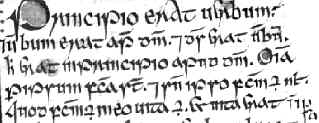 |
A
highly abbreviated version of the passage from the gospels of Maelbrigte (British
Library, Harley 1802, f.128), a 12th century Irish manuscript. By permission
of the British Library. |
|
In
principio erat uerbum et uerbum erat apud deum et deus erat uerbum. Hoc erat
in principio apud deum. Omnia per ipsum facta sunt et sine ipso factum est
nihil. Quod factum est in eo uita est et uita erat (lux hominum et lux in
tenebris lucet et tenebre eam non comprehenderunt). |
|
The
full passage as written in the manuscript is a sacred visual and verbal
puzzle. There are many abbreviations apart from the the nomina sacra term
dm for deum,
but the whole thing indicates that abbreviation was not regarded as diminishing
a text, even one with holy content. |
 |
Decorative
heading in an 11th century gospel book (Cambridge, Trinity College Library,
MS.B.10.4). |
|
In
this example the nomina sacra abbreviation IHU for Iesu (Jesus)
appears in a very formal and decorative heading, part of a large and elaborate
introduction page to the gospel of St Matthew. |
|
These
abbreviations alter their endings according to their grammatical position
in a sentence, as the full words would do if written out. This means there
are variants on each term. While there are various lists of abbreviations
around, they do tend to dissolve into rows of little black squiggles if
you look at them for too long, even though they are very handy for reference.
Here I intend to collect together images from real examples so that they
can be seen in a range of different scripts and with different forms of
abbreviation marks. The collection will gradually grow, hopefully into
a little visual reference library. Click on each term for a set of examples.
The
following are the most important terms:
- Deus
- dominus
- Iesu
- Christus
- sanctus
- spiritus
|
 Abbreviations Abbreviations |
 What is Paleography? What is Paleography? |
|
 |
 |
 |
 |
 |
 |
 |







